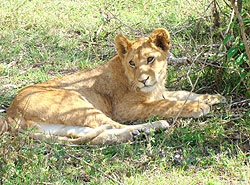
|
|
Pensive young lion |
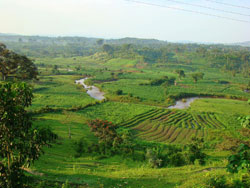
|
|
Uganda tea and banana farms |

|
|
Giraffe |
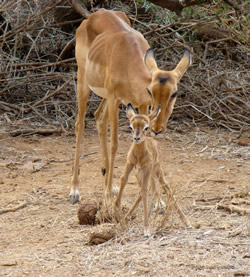
|
|
Newborn impala and mom |
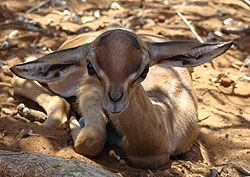
|
|
Two day old gerenuk |

|
|
Leopard on the move |

|
|
Rhino and baby |
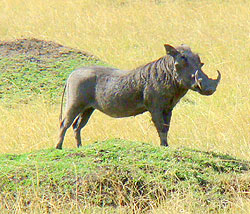
|
|
Proud warthog |
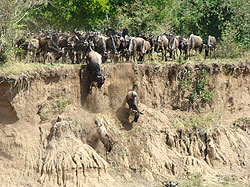
|
|
Frenzy to make the crossing |

|
|
Wildebeest crossing the Mara |

|
|
Male lions enjoying their rest |

|
|
Cheetahs resting |

|
|
Animals at waterhole
Karen Blixen Camp |
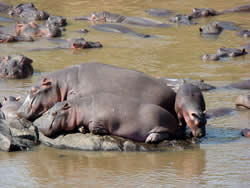
|
|
Hippos and babies |
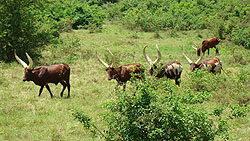
|
|
Uganda longhorn cattle |

Don and I just returned from a scouting trip to East Africa,
flying through Dubai, where we spent two nights. We are putting
together a proposed itinerary for an East African safari
adventure, using the wonderful experiences we have enjoyed
during our visits to Tanzania last year and Kenya and Uganda
this year. Having driven for long hours over miserable roads,
we know we will fly to many of our destinations so that we
have more time to enjoy the animals and the luxury camps.
We hope this report will entice you to join us, probably
in the fall of 2010, on what is truly the trip of a lifetime.
Meanwhile, read on to see what we learned and enjoy our photos
and the beautiful animals that populate this fascinating
part of the world.
Dubai is a city state, part of the United Arab Emirates,
ruled by a sheikh who is one of the Emir's cousins. The various parts of the UAE are pretty independent, but the emir, who
lives in Abu Dhabi, can still call the shots if there is
some overarching disagreement. The city has seen a massive
construction boom and, despite the severe downturn in its
finances, is still doing some building, including seven palm-shaped
islands in the Persian Gulf (all landfills). The ruling sheikh
has decided that Dubai will be the financial center of the
Middle East and is well on his way to reaching his goal.
While in Dubai, we visited the world's largest shopping center,
wandered through the old gold market (souk), and rode their
newly opened metro, which is still under construction at
many points along its way. Dubai also is about to open the
world's tallest building. It's quite an ambitious place,
the Middle East headquarters for many global banks and corporations,
which have large buildings there.
We talked to quite a few people in Dubai, waitresses, cab drivers,
shop owners, other workers. Only about 11% of the residents
are "native." Most come from all over the Middle East, the
Philippines and Central Asia. Our waitresses in a Japanese
restaurant were all Philippinas. They said life in Dubai is "very
hard." They work very long hours and don't always get their
one day off a week. They live in dormitories, probably much
like factory workers in China. They all work in Dubai to save
money and to send money home to their families. The rug merchant
we spent time with told us he's from Nepal, has a wife and
daughter in Nepal, and tries to get home once a year. He said
he can't support his family if he lives in Nepal. But, his
visa is about to expire, so he plans to move home and worries
that he won't be able to find work. He wants to build houses,
but found that he can't sell the "nice" home he built last
year because it's not what Nepalese are used to.
We flew from Dubai to Nairobi on Emirates Airlines, a great
airline that actually provides real service in coach and
even offers some room for your legs.
We spent the night in Nairobi before going to a tiny city
airport that provides air service to game parks all over
Kenya. Our plane was an 18-seater that flew very low so we
could see all the farming. Kenya is experiencing a terrible
drought in the north, so the ground is virtually bare. But,
we flew over the Kenya highlands (which we later drove across),
lush with banana, tea, coffee and wheat plantations. Except
in the highlands, which were known as the "white highlands" during
the British colonial period, farming in both Kenya and Uganda
is by hand. The earth is turned over with a wooden spade
and the ubiquitous hoe—the essential farm tool—is used
to break up the huge clods of earth, dig out the weeds, smooth
the soil and prepare it for planting. Then, of course, it
is used daily to keep the fields weeded. As one person told
us, you cannot farm a very large plot of land if all you
have is a hoe. So, throughout most of Kenya, the farms are
quite small because they are the size that one family can
manage to farm entirely by hand. The same is true in Uganda.
Samburu National Park was our first game park. We landed
at a little dirt runway. There were a couple of huts and
a few Samburu guides waiting for us, as well as a weathered
board that said "Duty Free Shop Here." Our guide, Robert,
met us with a large Land Cruiser that had a pop-up top for
better game viewing. Samburu is truly desperate. The animals
are starving to death. Starvation has already claimed many
of them, making great fodder for hyenas and vultures. We
drove by one calf that was dead—but then we saw an ear flicker.
That was all the poor little thing could muster. He wasn't
going to last more than an hour or so. The predators are
fat and fit, however, since their weakened prey are easy
to run down. The Samburu say, "This is just nature." But,
they are very worried about the fate of their animals and
themselves. Starvation is always at hand for the people,
too. We saw one newly born impala whose mother was all ribs,
no flesh. We wondered how she could possibly provide milk
for her baby.
The rivers are all dry in NW Kenya. The Samburu warriors
(the young men) dig wells in the bottom of the dry river
beds for their livestock and the wild animals in the park.
Otherwise, there is no water. A group of women walked along
the dry river bed in front of our tent camp singing a rain
song and dancing a rain dance in hopes of bringing rain.
The staff told us that would surely bring them rain.
We took a guided walk one afternoon and saw a tiny gerenuk
(an antelope with a long neck and skinny legs, found only
in the Samburu area). It couldn't have been more than a couple
of days old and had no fear of us. It lay down in the shade
of a bush and didn't move when we approached it. We didn't
touch it, of course, but could have. It had very long ears
and a tiny muzzle—so very adorable. Our guide pointed out
useful plants, including a toothbrush bush. If you cut off
a piece of the stem and massage it with your fingers, it
flares into many strong strands that the Samburu use to brush
their teeth.
One of the highlights was seeing a leopard, first lying
on the ground, then ambling off to climb a tree. He walked
right in front of us before draping himself over a large
limb. About 15 minutes later, he walked down the branch,
leaped to the ground and wandered off to hunt. Such a beautiful creature.
Samburu is close to the border with Somalia, so has thousands
of refugees living in the area. The Somalis are Muslim, while
the Kenyans are Christian or animist. Everyone is extremely
poor, living mostly in mud or concrete hovels. Clearly, there
is no employment opportunity. People have to farm, but the
land isn't theirs and the drought has made it impossible
to grow crops anyway.
When we left Samburu, we drove across the Kenya Highlands,
past Mount Kenya (16,800', with a technical climb to the
summit), and on to Lake Nakuru, a six hour drive mostly on
awful roads. We only had one night there, so went to see
the flamingos and resident white rhinos. In addition to the
rhinos, which we'd never seen up close before (we saw eight,
including a baby), we watched for about an hour as a pride
of eight lionesses hunted a water buffalo. They spent most of
their time thinking about it and moving slowly into position
and it was fascinating to watch their movements. Some of
the younger ones wrestled while they waited, alerting the
gazelles that had been the first target of the senior lioness,
so they took off. Eventually, as the lions got closer to
the buffalo, three other males came up from the lake and chased
them off.
On to Masai Mara, another five hour drive over very rough
roads. The reserve is divided into three parts, with the Mara
River running between them. In the north, where we were,
the reserve is privately leased by a group of resorts, all
luxury tent camps. But because of the drought, they have
opened that part of the reserve to the Masai to graze their herds. Masai Mara has had some rain and is quite green. There is even substantial
grass in some parts, so the animals look far better than
the ones in Samburu. It is a huge area, the extension of
Tanzania's Serengeti Plain into Kenya. On the northern part
of the reserve, where the Masai are grazing their cattle,
the grass is pretty marginal, but south of the grazing area,
where cattle are not allowed, it's quite lush. When we arrived
at our camp, which was beautiful, we found zebra, giraffes,
eland, gazelles and warthogs drinking from the Mara River,
which runs right by the tents. A large group of about fifty
hippos occupies a big pool just below the dining room. The
Masai Mara isn't controlled as carefully as the Tanzanian
parks, where you can only drive on prescribed tracks. Here,
the tourist vehicles drive all over the ground, ruining the
grass and leaving huge erosion channels when the rains come.
The Mara River is the famous river where the wildebeest
cross by the thousands during their migrations in the spring
and fall. Some are picked off by the waiting crocodiles who
loll on the banks near the crossing points. We were lucky
enough to watch a crossing. At one of the main crossing points,
we saw eight or ten crocodiles, lying in the sun. There was a
partially eaten wildebeest floating nearby, victim of an
earlier, unsuccessful, attempt to cross the river, which
isn't very wide or even terribly deep, but a real challenge
for the wildebeest.
Typically, the wildebeest herds mass on one side of the
river before they cross. The group we watched numbered many
hundreds. We could see them running from all over the south
side of the river to one gathering spot. Then they all moved
up river from the crocodiles (not by design, I'm sure, but
just by luck) to another crossing point. They stood around
for the better part of an hour staring at the river, trying
to decide if they should go. Periodically one would break
out of the herd and head towards the water, only to turn
back. Finally one brave creature plunged into the water and
started bounding across. At that point, the entire herd followed
madly, leaping off a cliff, crashing into the water and swimming
frantically to our side. Then they all just wandered off
grazing as if nothing unusual had occurred, their coats all
wet and silvery in the sunlight.
Our next great find was a pride of lions, including a large
male. They were sleeping under a tree, obviously stuffed
from the previous night's successful hunt. We drove off to
find a tree for our picnic lunch (they are yellow bark acacias,
very tall, with spreading canopies, but they're sparsely
scattered over the savannah). As we drove up to the tree
we'd picked, we saw two huge male lions asleep underneath and
watched them for a while before looking for an alternative
lunch spot. Their breathing was surprisingly fast, panting
really, even though they were sound asleep and paid no attention to us.
Four cheetahs were asleep under another tree. Later, they
moved off towards the gazelles grazing far away on the plain.
There was a Disney film crew that had been following them
all day, hoping to film them hunting.
Both the tent camps in Samburu and Masai Mara were wonderful. Spacious tents right on the river (dry in Samburu, flowing
fast in Masai Mara), small camps, lovely common areas for
meals and socializing and good food. In Masai Mara, you have
to wait for one of the guards to escort you to and from your
tent at night because there are so many animals in the surrounding bush and drinking at the River. The elephants and water buffalo
are the most dangerous.
We flew from Masai Mara back to Nairobi and then on to
Entebbe, Uganda. There are two airlines that serve the four airstrips in Masai Mara. They hop from one to the other before continuing
on to Nairobi. We were stop number three, which is preferable
to being stop number one. Entebbe is the old British capital
of Uganda, with the Governor's Residence, now occupied by
the President. But, the capital is now in Kampala, about
30 miles and an hour's drive north from Entebbe (where Uganda's international airport is located), which is right on Lake
Victoria. As we flew into Entebbe, we crossed Lake Victoria
for some time, looking down at hundreds of islands, some
very far out, and all occupied by farmers and fishermen.
It was a thrill for me to finally see this huge lake, the
source of the Nile, which has played such a prominent role
in African exploration and history. On our way back through
Entebbe, we stopped so we could put our fingers in the water.
Kampala is a large city built on a number of hills. Like
Nairobi, it has a real mix of great wealth and (mostly) extreme poverty. The roads are lined with tiny shops and houses,
most dark, dank and dirty, though the roads are surprisingly
clean. There are also large mansions on the higher hillsides,
all protected by high walls. Uganda is much more tropical
than Kenya, so has had lots of rain and is very lush. Farming
here is also by hand, even the tea and banana plantations
which predominate on the hillsides. It is very hard work.
The soil looks very good, but many of the farms are on steep
mountainsides, so obviously extremely difficult to farm.
Uganda has a unique breed of cattle with huge horns that
curve out from the sides of their heads in big arcs, more
vertical than Longhorns.
Our destination was the Bwindi Impenetrable National Park,
home to 370 of the rare mountain gorillas. You can fly to
an airstrip or drive on mostly poor roads. We wanted to see
the country, so drove for eleven hours to get to Bwindi; a long
day, but very beautiful scenery and very interesting towns
and villages. Uganda is about to conduct another census and
expects its population to have more than doubled from ten
years ago, from 6 to 13 million. There are people everywhere.
The roads are crowded, not with carts drawn by donkeys (there
are no donkeys—probably due to the tse tse fly), but with
pedestrians and many bicycles. The bicycles are used like
carts, with their owners usually pushing huge loads of bananas
or charcoal or reeds up the long hills to the local markets.
According to our guide, the government thinks rapid population
growth is fine. But, clearly there aren't jobs for the large
numbers of young people. We saw dozens of schools, many private. While primary education is free in government schools, there
are fees for secondary and private schools, which most people
can't afford (in the range of $200 per year in a country
where most people make less than $400 per year). Nonetheless,
we saw thousands of kids in their school uniforms walking
to and from school. Unfortunately, we also too many kids
not in school because their parents don't think it's important
(according to our guide, who seemed to think Uganda would
be better off with a dictator who required all kids to go
to school).
We talked to the manager of our tent camp in Bwindi one
night. He is from the Northeastern part of Uganda, near the
Sudan border. He told us how hard life is for his family
because of the constant fighting for the last two decades.
He said all their animals had been stolen many years ago
(animals are the measure of wealth for his tribe as well
as for the Masai and Samburu), so they had to farm by hand
on very small plots. Drought had wiped them out over and
over. Soldiers from warring factions in Sudan frequently
cross the border to raid in Uganda, killing people and stealing crops (there are no animals left to steal).
In Bwindi, groups searching for the gorillas are limited to
eight people per guide, plus armed guard. The Reserve sends trackers
out early in the morning to find the gorillas because treks
are limited to eight hours for finding and watching the gorillas.
That would be a long day, traipsing through the rain forest.
Each tourist group is assigned to a particular gorilla family.
Our trackers had spotted ours even before we left the headquarters, so it only took us 45 minutes to find the gorillas. You can
spend an hour with these beautiful animals. Our family has
eighteen members (the guides know each one by name and personality)
and we saw eleven of them, including a huge (650 pound) silverback
male, the leader of the family. There were a number of babies,
the responsibility of all the adults in the family. They were
not bothered by us at all and just lolled around eating and
grooming, babies and youngsters playing in the trees. They
were very quiet.
You are not allowed to get closer than twenty feet, because
the gorillas get human diseases so easily, but we ended up
being right next to them. One baby even crept up to Don's
backside and started plucking at his pants and shirt and
grabbed his hand when he reached around to see what was going
on. A woman in our group realized she'd lost her binoculars
when we got out of the forest. She and the guide went back
to find them. They found a young gorilla trying to figure
out how to use them, moving them back and forth and looking
into the glasses. He had picked them out of her pocket. The
woman and our guide waited until the silverback signaled
it was time to move on. The young gorilla dropped the binoculars and took off with his family.
The chimps we tracked in Kibale Forest National Park were completely
different. They are the closest of the primates to humans.
Unlike the gorillas, they kept moving all the time. We traipsed
along after them, crawling through the vines and underbrush
filling the spaces between the huge trees the chimps love.
They are very noisy, with screams, howls, and grunts to signal
what they are doing and where they are going. They use the
long thin root systems of banyan trees like a drum, beating
on them to communicate where they are going. When the head
male comes along the trail, all the other chimps scramble up
the trees as fast as they can, screeching all the while. If
they're too slow, the "daddy" of the family swats them firmly
and sends them scampering up the nearest tree. The chimps moved
up and down the trees very rapidly. Sometimes, one would crash
down, catching himself by grabbing a vine or branch on the
way down. It was all very fast and very noisy. We tracked them
for an hour. The jungle was absolutely filled with their calls
and motion.

Back to top

|


